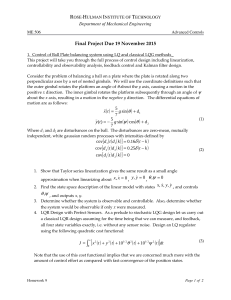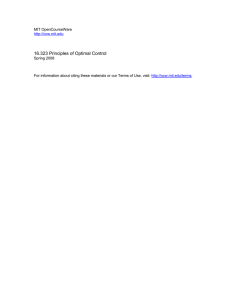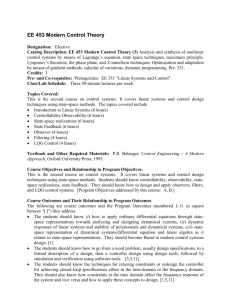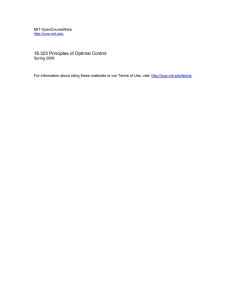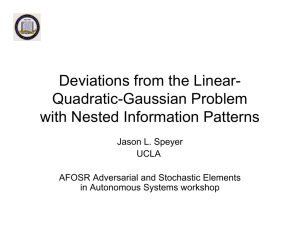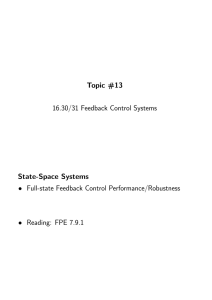16.323 Principles of Optimal Control
advertisement
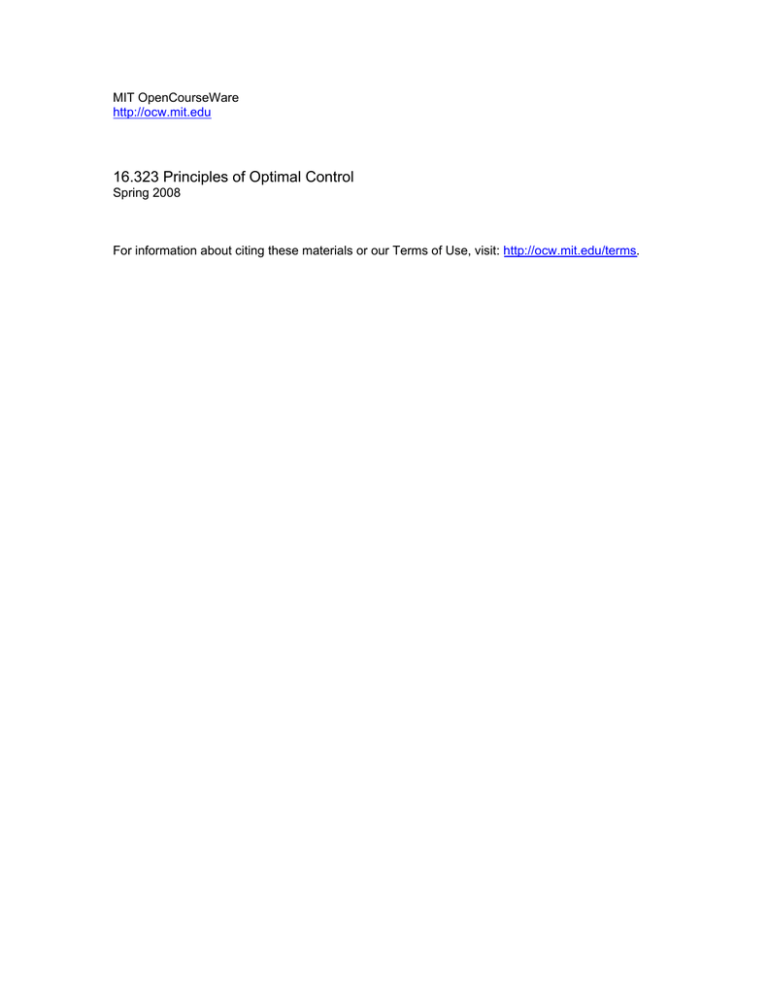
MIT OpenCourseWare
http://ocw.mit.edu
16.323 Principles of Optimal Control
Spring 2008
For information about citing these materials or our Terms of Use, visit: http://ocw.mit.edu/terms.
16.323 Lecture 12
Stochastic Optimal Control
• Kwaknernaak and Sivan Chapter 3.6, 5
• Bryson Chapter 14
• Stengel Chapter 5
Spr 2008
Stochastic Optimal Control
16.323 12–1
• Goal: design optimal compensators for systems with incomplete and
noisy measurements
– Consider this first simplified step: assume that we have noisy system
with perfect measurement of the state.
• System dynamics:
ẋ(t) = A(t)x(t) + Bu(t)u(t) + Bw (t)w(t)
– Assume that w(t) is a white Gaussian noise 20 ⇒ N (0, Rww )
– The initial conditions are random variables too, with
E[x(t0)] = 0, and E[x(t0)xT (t0)] = X0
– Assume that a perfect measure of x(t) is available for feedback.
• Given the noise in the system, need to modify our cost functions from
before ⇒ consider the average response of the closed-loop system
�
�
�
1 T
1 tf T
Js = E
x (tf )Ptf x(tf ) +
(x (t)Rxx(t)x(t) + uT (t)Ruu(t)u(t))dt
2
2 t0
– Average over all possible realizations of the disturbances.
• Key observation: since w(t) is white, then by definition, the corre­
lation times-scales are very short compared to the system dynamics
– Impossible to predict w(τ ) for τ > t, even with perfect knowledge
of the state for τ ≤ t
– Furthermore, by definition, the system state x(t) encapsulates all
past information about the system
– Then the optimal controller for this case is identical to the deter­
ministic one considered before.
20 16.322
Notes
June 18, 2008
Spr 2008
16.323 12–2
Spectral Factorization
• Had the process noise w(t) had “color” (i.e., not white), then we need
to include a shaping filter that captures the spectral content (i.e.,
temporal correlation) of the noise Φ(s)
– Previous picture: system is y = G(s)w1, with white noise input
w1
�
G(s)
y
�
– New picture: system is y = G(s)w2, with shaped noise input
w2
�
G(s)
y
�
• Account for the spectral content using a shaping filter H(s), so that
the picture now is of a system y = G(s)H(s)w1, with a white noise
input
w1
�
H(s)
w̃2
�
G(s)
y
�
– Then must design filter H(s) so that the output is a noise w̃2 that
has the frequency content that we need
• How design H(s)? Spectral Factorization – design a stable mini­
mum phase linear transfer function that replicates the desired spectrum
of w2.
– Basis of approach: If e2 = H(s)e1 and e1 is white, then the spec­
trum of e2 is given by
Φe2 (jω) = H(jω)H(−jω)Φe1 (jω)
where Φe1 (jω) = 1 because it is white.
June 18, 2008
Spr 2008
16.323 12–3
• Typically Φw2 (jω) will be given as an expression in ω 2, and we factor
that into two parts, one of which is stable minimum phase, so if
2σ 2α2
Φw2 (jω) = 2
ω√ + α2 √
2σα
2σα
=
·
= H(jω)H(−jω)
α + jω α − jω
√
so clearly H(s) =
2σα
s+α
which we write in state space form as
√
ẋH = −αxH + 2ασw1
w2 = xH
• More generally, the shaping filter will be
ẋH = AH xH + BH w1
w2 = CH xH
which we then augment to the plant dynamics, to get:
�
��
�
�
� �
�
�
�
A Bw CH
ẋ
x
Bu
0
=
+
u+
w1
ẋH
x
0
B
H
H
0 AH
�
�
�
� x
y = Cy 0
xH
where the noise input w1 is a white Gaussian noise.
• Clearly this augmented system has the same form as the original system
that we analyzed - there are just more states to capture the spectral
content of the original shaped noise.
June 18, 2008
Spr 2008
Disturbance Feedforward
16.323 12–4
• Now consider the stochastic LQR problem for this case.
– Modify the state weighting matrix so that
�
�
Rxx 0
R̃xx =
0 0
⇒ i.e. no weighting on the filter states – Why is that allowed?
– Then, as before, the stochastic LQR solution for the augmented
system is the same as the deterministic LQR solution (6–9)
�
�
�
� x
u = − K Kd
xH
– So the full state feedback controller requires access to the state in
the shaping filter, which is fictitious and needs to be estimated
• Interesting result is that the gain K on the system states is com­
pletely independent of the properties of the disturbance
– In fact, if the solution of the steady state Riccati equation in this
case is partitioned as
�
�
Pxx PxxH
Paug =
PxHx PxHxH
it is easy to show that
�Pxx can be solved for independently, and
� Is the same as it would be in the deterministic case with the dis­
turbances omitted 21
– Of course the control inputs that are also based on xH will improve
the performance of the system ⇒ disturbance feedforward.
21 K+S
pg 262
June 18, 2008
Spr 2008
Performance Analysis
16.323 12–5
• Recall that the specific initial conditions do not effect the LQR con­
troller, but they do impact the cost-to-go from t0
– Consider the stochastic LQR problem, but with w(t) ≡ 0 so that
the only uncertainty is in the initial conditions
– Have already shown that LQR cost can be written in terms of the
solution of the Riccati equation (4–7):
JLQR =
⇒Js =
=
=
which gives expected
1 T
x (t0)P (t0)x(t0)
2 �
�
1 T
E
x (t0)P (t0)x(t0)
2
�
1 �
T
E trace[P (t0)x(t0)x (t0)]
2
1
trace[P (t0)X0]
2
cost-to-go with uncertain IC.
• Now return to case with w �= 0 – consider the average performance
of the stochastic LQR controller.
• To do this, recognize that if we apply the LQR control, we have a
system where the cost is based on zT Rzzz = xT Rxxx for the closedloop system:
ẋ(t) = (A(t) − Bu(t)K(t))x(t) + Bw (t)w(t)
z(t) = Cz (t)x(t)
• This is of the form of a linear time-varying system driven by white
Gaussian noise – called a Gauss-Markov Random process22.
22 Bryson
11.4
June 18, 2008
Spr 2008
16.323 12–6
• For a Gauss-Markov system we can predict the mean square value
of the state X(t) = E[x(t)x(t)T ] over time using X(0) = X0 and
Ẋ(t) = [A(t) − Bu(t)K(t)] X(t) + X(t) [A(t) − Bu(t)K(t)]T + Bw Rww BwT
– Matrix differential Lyapunov Equation.
• Can also extract the mean square control values using
E[u(t)u(t)T ] = K(t)X(t)K(t)T
• Now write performance evaluation as:
Js
�
�
� tf
1
T
T
T
= E x (tf )Ptf x(tf ) +
(x (t)Rxx (t)x(t) + u (t)Ruu (t)u(t))dt
2
t0
��
�
�
� tf
1
T
T
T
= E trace Ptf x(tf )x (tf ) +
(Rxx (t)x(t)x (t) + Ruu (t)u(t)u (t))dt
2
t0
�
�
� tf
1
T
= trace Ptf X(tf ) +
(Rxx (t)X(t) + Ruu (t)K(t)X(t)K(t) )dt
2
t0
• Not too useful in this form, but if P (t) is the solution of the LQR
Riccati equation, then can show that the cost can be written as:
�
�
� tf
1
Js = trace P (t0)X(t0) +
(P (t)Bw Rww BwT )dt
2
t0
– First part, 12 trace {P (t0)X(t0)} is the same cost-to-go from the
uncertain initial condition that we identified on 11–5
– Second part shows that the cost increases as a result of the process
noise acting on the system.
June 18, 2008
Spr 2008
16.323 12–7
• Sketch of Proof: first note that
�
P (t0)X(t0) − Ptf X(tf ) +
tf
t0
d
(P (t)X(t))dt = 0
dt
�
�
1
Js = trace Ptf X(tf ) + P (t0)X(t0) − Ptf X(tf )
2
�� tf
�
1
+ trace
{Rxx(t)X(t) + Ruu(t)K(t)X(t)K(t)T }dt
2
��t0tf
�
1
+ trace
{Ṗ (t)X(t) + P (t)Ẋ(t)}dt
2
t0
−1 T
and (first reduces to standard CARE if K(t) = Ruu
Bu P (t))
−Ṗ (t)X(t) = (A − BuK(t))T P (t)X(t) + P (t)(A − BuK(t))X(t)
+RxxX(t) + K(t)T RuuK(t)X(t)
P (t)Ẋ(t) = P (t)(A − BuK(t))X(t) + P (t)X(t)(A − BuK(t))T
+P (t)Bw Rww BwT
• Rearrange terms within the trace and then cancel terms to get final
result.
June 18, 2008
Spr 2008
Steady State Values
16.323 12–8
• Problems exist if we set t0 = 0 and tf → ∞ because performance will
be infinite
– Modify the cost to consider the time-average
1
Ja = lim
Js
tf →∞ tf − t0
– No impact on necessary conditions since this is still a fixed end-time
problem.
– But now the initial conditions become irrelevant, and we only need
focus on the integral part of the cost.
• For LTI system with stationary process noise (constant Rww ) and wellposed time-invariant control problem (steady gain u(t) = −Kssx(t))
mean square value of state settles down to a constant
lim X(t) = Xss
tf →∞
0 = (A − BuKss) Xss + Xss (A − BuKss)T + Bw Rww BwT
– Can show that time-averaged mean square performance is
�
�
1
T
Ja = trace [Rxx + KssRuuKss]Xss
2
1
≡ trace[PssBw Rww BwT ]
2
• Main point: this gives a direct path to computing the expected
performance of a closed-loop system
– Process noise enters into computation of Xss
June 18, 2008
Missile Example
Spr 2008
16.323 12–9
• Consider a missile roll attitude control system with ω the roll angular
velocity, δ the aileron deflection, Q the aileron effectiveness, and φ
the roll angle, then
1
Q
ω̇ = − ω + δ + n(t)
φ̇ = ω
τ
τ
where n(t) is a noise input.
• Then this can be written as:
⎡ ⎤ ⎡
⎤⎡ ⎤ ⎡ ⎤
⎡ ⎤
δ̇
0
0 0
δ
1
0
⎣ ω̇ ⎦ = ⎣ −1/τ Q/τ 0 ⎦ ⎣ ω ⎦ + ⎣ 0 ⎦ u + ⎣ 1 ⎦ n
0
1 0
φ
0
0
φ̇
δ̇ = u
• Use τ = 1, Q = 10, Ruu = 1/(π)2 and
⎡
⎤
(π/12)2 0
0
⎦
Rxx = ⎣
0
0
0
0
0 (π/180)2
then solve LQR problem to get feedback gains:
K=lqr(A,B,Rxx,Ruu)
K = [26.9 29.0 180.0]
• Then if n(t) has a spectral density of 1000 (deg/sec2)2· sec
23
• Find RMS response of the system from
X=lyap(A-B*K,Bw*Rww*Bw’)
⎡
⎤
95 −42 −7
X = ⎣ −42 73
0⎦
−7
0 0.87
�
and that E[φ2] ≈ 0.93deg
�
23 Process noise input to a derivative of ω, so the units of n(t) must be deg/sec2 , but since E[n(t)n(τ )] = R
ww δ(t − τ ) and
δ(t)dt = 1, then the units of δ(t) are 1/sec and thus the units of Rww are (rad/sec2 )2 · sec=rad2 /sec3
June 18, 2008
Full Control Problem
Spr 2008
16.323 12–10
• Goal: design an optimal controller for a system with incomplete
and noisy measurements
• Setup: for the system (possibly time-varying)
ẋ = Ax + Buu + Bw w
z = Cz x
y = Cy x + v
with
– White, Gaussian noises w ∼ N (0, Rww ) and v ∼ N (0, Rvv ), with
Rww > 0 and Rvv > 0
– Initial conditions x(t0), a stochastic vector with E[x(t0)] = x̄0 and
E[(x(t0) − x̄0)(x(t0) − x̄0)T ] = Q0 so that
x(t0) ∼ N (x̄0, Q0)
• Cost:
�
J =E
1 T
1
x (tf )Ptf x(tf ) +
2
2
� tf
�
(zT (t)Rzzz(t) + uT (t)Ruuu(t))dt
t0
with Rzz > 0, Ruu > 0, Ptf ≥ 0
• Stochastic Optimal Output Feedback Problem: Find
u(t) = f [y(τ ), t0 ≤ τ ≤ t]
t0 ≤ t ≤ tf
that minimizes J
• The solution is the Linear Quadratic Gaussian Controller, which uses
– LQE (10–15) to get optimal state estimates x̂(t) from y(t) using
gain L(t)
– LQR to get the optimal feedback control u(t) = −K(t)x
– Separation principle to implement u(t) = −K(t)x̂(t)
June 18, 2008
Solution: LQG
Spr 2008
16.323 12–11
• Regulator: u(t) = −K(t)x̂(t)
−1 T
Bu P (t)
K(t) = Ruu
−1 T
−Ṗ (t) = AT P (t) + P (t)A + CzT RzzCz − P (t)BuRuu
Bu P (t)
P (tf ) = Ptf
• Estimator from:
x̂˙(t) = Ax̂ + Buu + L(t)(y(t) − Cy x̂(t))
where x̂(t0) = x̄0 and Q(t0) = Q0
−1
Q̇(t) = AQ(t) + Q(t)AT + Bw Rww BwT − Q(t)CyT Rvv
Cy Q(t)
−1
L(t) = Q(t)CyT Rvv
• A compact form of the compensator is:
ẋc = Acxc + Bcy
u = −Ccxc
with xc ≡ x̂ and
Ac = A − BuK(t) − L(t)Cy
Bc = L(t)
Cc = K(t)
• Valid for SISO and MIMO systems. Plant dynamics can also be timevarying, but suppressed for simplicity.
– Obviously compensator is constant if we use the steady state regu­
lator and estimator gains for an LTI system.
June 18, 2008
Spr 2008
Infinite Horizon LQG
16.323 12–12
• Assuming LTI plant
• As with the stochastic LQR case, use time averaged cost
– To ensure that estimator settles down, must take t0 → −∞ and
tf → ∞, so that for any t, t0 � t � tf
¯ = lim
J
tf →∞
t0 →−∞
1
J
tf − t0
– Again, this changes the cost, but not the optimality conditions
• Analysis of J¯ shows that it can be evaluated as
J¯ = E[zT (t)Rzzz(t) + uT (t)Ruuu(t)]
T
= Tr[PssLssRvv Lss
+ QssCzT RzzCz ]
T
= Tr[PssBw Rww BwT + QssKss
RuuKss]
where Pss and Qss are the steady state solutions of
−1 T
AT Pss + PssA + CzT RzzCz − PssBuRuu
Bu Pss = 0
−1
AQss + QssAT + Bw Rww BwT − QssCyT Rvv
Cy Qss = 0
with
−1 T
−1
Kss = Ruu
Bu Pss and Lss = QssCyT Rvv
• Can evaluate the steady state performance from the solution of 2
Riccati equations
– More complicated than stochastic LQR because J¯ must account for
performance degradation associated with estimation error.
– Since in general x̂(t) �= x(t), have two contributions to the cost
�Regulation error x �= 0
�Estimation error x̃ �= 0
June 18, 2008
Spr 2008
Interpretations
16.323 12–13
• Note that
J¯ = Tr[PssLssRvv LTss + QssCzT RzzCz ]
T
= Tr[PssBw Rww BwT + QssKss
RuuKss]
both of which contain terms that are functions of the control and
estimation problems.
• To see how both terms contribute, let the regulator get very fast
⇒ Ruu → 0. A full analysis requires that we then determine what
¯ But what is clear is that:
happens to Pss and thus J.
lim J¯ ≥ Tr[QssCzT RzzCz ]
Ruu →0
which is independent of Ruu
– Thus even in the limit of no control penalty, the performance is
lower bounded by term associated with estimation error Qss.
• Similarly, can see that limRvv →0 J¯ ≥ Tr[PssBw Rww BwT ] which is re­
lated to the regulation error and provides a lower bound on the per­
formance with a fast estimator
– Note that this is the average cost for the stochastic LQR problem.
• Both cases illustrate that it is futile to make either the estimator or
regulator much “faster” than the other
– The ultimate performance is limited, and you quickly reach the
“knee in the curve” for which further increases in the authority of
one over the other provide diminishing returns.
– Also suggests that it is not obvious that either one of them should
be faster than the other.
• Rule of Thumb: for given Rzz and Rww , select Ruu and Rvv so that
the performance contributions due to the estimation and regulation
error are comparable.
June 18, 2008
Spr 2008
Separation Theorem
16.323 12–14
• Now consider what happens when the control u = −Kx is changed
to the new control u = −Kx̂ (same K).
– Assume steady state values here, but not needed.
– Previous looks at this would have analyzed the closed-loop stability,
as follows, but we also want to analyze performance.
plant :
compensator :
ẋ = Ax + Buu + Bw w
z = Cz x
y = Cy x + v
ẋc = Acxc + Bcy
u = −Ccxc
• Which give the closed-loop dynamics
� �
�
�� � �
�� �
A −BuCc
x
Bw 0
w
ẋ
=
+
xc
v
ẋc
BcCy
Ac
0 Bc
� �
�
� x
z = Cz 0
xc
� �
�
� x
y = Cy 0
+v
xc
• It is not obvious that this system will even be stable: λi(Acl) < 0?
– To analyze, introduce n = x − xc, and the similarity transform
�
�
� �
� �
I 0
x
x
T =
= T −1
=T
⇒
I −I
n
xc
so that Acl ⇒ T AclT −1 ≡ Acl and when you work through the
math, you get
�
�
A − BuK BuK
Acl =
0
A − LCy
June 18, 2008
Spr 2008
16.323 12–15
• Absolutely key points:
1. λi(Acl) ≡ λi(Acl)
2. Acl is block upper triangular, so can find poles by inspection:
det(sI − Acl) = det(sI − (A − BuK)) · det(sI − (A − LCy ))
The closed-loop poles of the system consist of the
union of the regulator and estimator poles
– This shows that we can design any estimator and regulator sepa­
rately with confidence that the combination will stabilize the system.
� Also means that the LQR/LQE problems decouple in terms of
being able to predict the stability of the overall closed-loop system.
• Let Gc(s) be the compensator transfer function (matrix) where
u = −Cc(sI − Ac)−1Bcy = −Gc(s)y
– Reason for this is that when implementing the controller, we often
do not just feedback −y(t), but instead have to include a reference
command r(t)
– Use servo approach and feed back e(t) = r(t) − y(t) instead
r e
�
�
Gc(s)
u
�
y
G(s)
�
−
– So now u = Gce = Gc(r−y), and if r = 0, then have u = Gc(−y)
• Important points:
– Closed-loop system will be stable, but the compensator dynamics
need not be.
– Often very simple and useful to provide classical interpretations of
the compensator dynamics Gc(s).
June 18, 2008
Spr 2008
Performance Optimality
16.323 12–16
• Performance optimality of this strategy is a little harder to establish
– Now saying more than just that the separation principle is a “good”
idea ⇒ are trying to say that it is the “best” possible solution
• Approach:
– Rewrite cost and system in terms of the estimator states and dy­
namics ⇒ recall we have access to these
– Design a stochastic LQR for this revised system ⇒ full state feed­
back on x̂(t)
• Start with the cost (use a similar process for the terminal cost)
E[zT Rzzz] = E[xT Rxxx]
{±x̂}
= E[(x − x̂ + x̂)T Rxx(x − x̂ + x̂)]
{x̃ = x − x̂}
= E[x̃T Rxxx̃] + 2E[x̃T Rxxx̂] + E[x̂T Rxxx̂]
• Note that x̂(t) is the minimum mean square estimate of x(t) given
y(τ ), u(τ ), t0 ≤ τ ≤ t.
– Key property of that estimate is that x̂ and x̃ are uncorrelated24
E[x̃T Rxxx̂] = trace[E{x̃x̂T }Rxx] = 0
• Also,
E[x̃T Rxxx̃] = E[trace(Rxxx̃x̃T )] = trace(RxxQ)
where Q is the solution of the LQE Riccati equation (11–11)
• So, in summary we have:
E[xT Rxxx] = trace(RxxQ) + E[x̂T Rxxx̂]
24 Gelb,
pg 112
June 18, 2008
Spr 2008
16.323 12–17
• Now the main part of the cost function can be rewritten as
� � tf
�
1
J = E
(zT (t)Rzzz(t) + uT (t)Ruuu(t))dt
2
� �t0tf
�
1
= E
(x̂T (t)Rxxx̂(t) + uT (t)Ruuu(t))dt
2 t0
�
1 tf
+
(trace(RxxQ))dt
2 t0
– The last term is independent of the control u(t) ⇒ it is only a
function of the estimation error
– Objective now is to choose the control u(t) to minimize the first
term
• But first we need another key fact25: If the optimal estimator is
x̂˙(t) = Ax̂(t) + Buu(t) + L(t)(y(t) − Cy x̂(t))
then by definition, the innovations process
i(t) ≡ y(t) − Cy x̂(t)
is a white Gaussian process, so that i(t) ∼ N (0, Rvv + Cy QCyT )
• Then we can rewrite the estimator as
x̂˙(t) = Ax̂(t) + Buu(t) + L(t)i(t)
which is an LTI system with i(t) acting as the process noise through
a computable L(t).
25 Gelb,
pg 317
June 18, 2008
Spr 2008
16.323 12–18
• So combining the above, we must pick u(t) to minimize
� � tf
�
1
J =E
(x̂T (t)Rxxx̂(t) + uT (t)Ruuu(t))dt +term ind. of u(t)
2 t0
subject to the dynamics
x̂˙(t) = Ax̂(t) + Buu(t) + L(t)i(t)
– Which is a strange looking Stochastic LQR problem
– As we saw before, the solution is independent of the driving process
noise
u(t) = −K(t)x̂(t)
– Where K(t) is found from the LQR with the data A, Bu, Rxx, and
Ruu, and thus will be identical to the original problem.
• Combination of LQE/LQR gives performance optimal result.
June 18, 2008
Simple Example
Spr 2008
�
ẋ =
z =
1 0
0 1
�
�
x+
0 0
�
y =
0 1
�
�
0
u+
1
�
16.323 12–19
�
0
w
1
�
x
�
1 0 x+v
where in the LQG problem we have
�
�
1 0
Rzz =
Ruu = 1
0 1
Rvv = 1
Rww = 1
• Solve the SS LQG problem to find that
Tr[PssLssRvv LTss] = 8.0
Tr[PssBw Rww BwT ] = 1.7
Tr[QssCzT RzzCz ] = 2.8
T
Tr[QssKss
RuuKss] = 9.1
• Suggests to me that we need to improve the estimation error ⇒ that
Rvv is too large. Repeat with
�
�
1 0
Rzz =
Ruu = 1
Rvv = 0.1
Rww = 1
0 1
Tr[PssLssRvv LTss] = 4.1
Tr[PssBw Rww BwT ] = 1.7
Tr[QssCzT RzzCz ] = 1.0
T
Tr[QssKss
RuuKss] = 3.7
and
�
Rzz =
1 0
0 1
�
Ruu = 1
Tr[PssLssRvv LTss] = 3.0
Tr[PssBw Rww BwT ] = 1.7
June 18, 2008
Rvv = 0.01
Rww = 1
Tr[QssCzT RzzCz ] = 0.5
T
Tr[QssKss
RuuKss] = 1.7
Spr 2008
• LQG analysis code
A=[0 1;0 0];%
Bu=[0 1]’;%
Bw=[0 1]’; %
Cy=[1 0];%
Cz=[1 0;0 1];%
Rww=1;%
Rvv=1;%
Rzz=diag([1 1]);%
Ruu=1;%
[K,P]=lqr(A,Bu,Cz*Rzz*Cz’,Ruu);%
[L,Q]=lqr(A’,Cy’,Bw*Rww*Bw’,Rvv);L=L’;%
N1=trace(P*(L*Rvv*L’))%
N2=trace(Q*(Cz’*Rzz*Cz))%
N3=trace(P*(Bw*Rww*Bw’))%
N4=trace(Q*(K’*Ruu*K))%
[N1 N2;N3 N4]
June 18, 2008
16.323 12–20
Spr 2008
Stochastic Simulation
16.323 12–21
• Consider the linearized longitudinal dynamics of a hypothetical heli­
copter. The model of the helicopter requires four state variables:
– θ(t):fuselage pitch angle (radians)
– q(t):pitch rate (radians/second)
– u(t):horizontal velocity of CG (meters/second)
– x(t):horizontal distance of CG from desired hover (meters)
The control variable is:
– δ (t): tilt angle of rotor thrust vector (radians)
Figure by MIT OpenCourseWare.
Figure 12.1: Helicopter in Hover
• The linearized equation of motion are:
θ̇(t)
q̇(t)
u̇(t)
ẋ(t)
=
=
=
=
q(t)
−0.415q(t) − 0.011u(t) + 6.27δ(t) − 0.011w(t)
9.8θ(t) − 1.43q(t) − .0198u(t) + 9.8δ(t) − 0.0198w(t)
u(t)
– w(t) represents a horizontal wind disturbance
– Model w(t) as the output of a first order system driven by zero
mean, continuous time, unit intensity Gaussian white noise ξ(t):
ẇ(t) = −0.2w(t) + 6ξ(t)
June 18, 2008
Spr 2008
16.323 12–22
• First, treat original (non-augmented) plant dynamics.
– Design LQR controller so that an initial hover position error, x(0) =
1 m is reduced to zero (to within 5%) in approximately 4 sec.
Figure 12.2: Results show that Ruu = 5 gives reasonable performance.
• Augment the noise model, and using the same control gains, form the
closed-loop system which includes the wind disturbance w(t) as part
of the state vector.
• Solve necessary Lyapunov equations to determine the (steady-state)
variance of the position hover error, x(t) and rotor angle δ(t).
– Without feedforward:
�
�
2
E[x ] = 0.048
E[δ 2] = 0.017
• Then design a LQR for the augmented system and repeat the process.
– With feedforward:
�
�
2
E[x ] = 0.0019
E[δ 2] = 0.0168
June 18, 2008
Spr 2008
16.323 12–23
• Now do stochastic simulation of closed-loop system using Δt = 0.1.
– Note the subtly here that the design was for a continuous system,
but the simulation will be discrete
– Are assuming that the integration step is constant.
– Need to create ζ using the randn function, which gives zero mean
unit variance Gaussian noise.
– To scale it correctly
√ for a discrete simulation, multiply the 26output
of randn by 1/ Δt, where Δt is the integration step size.
– Could also just convert the entire system to its discrete time equiv­
alent, and then use a process noise that has a covariance
Qd = Rww /Δt
26 Franklin
and Powell, Digital Control of Dynamic Systems
June 18, 2008
Spr 2008
16.323 12–24
Figure 12.3: Stochastic Simulations with and without disturbance feedforward.
June 18, 2008
Spr 2008
16.323 12–25
Helicopter stochastic simulation
1
2
3
4
5
6
7
8
9
10
11
12
13
% 16.323 Spring 2008
% Stochastic Simulation of Helicopter LQR
% Jon How
%
clear all, clf, randn(’seed’,sum(100*clock));
% linearized dynamics of the system
A = [ 0 1 0 0; 0 -0.415 -0.011 0;9.8 -1.43 -0.0198 0;0 0 1 0];
Bw = [0 -0.011 -0.0198 0]’;
Bu = [0 6.27 9.8 0]’;
Cz = [0 0 0 1];
Rxx = Cz’*Cz;
rho = 5;
Rww=1;
14
15
16
17
18
% lqr control
[K,S,E]=lqr(A,Bu,Rxx,rho);
[K2,S,E]=lqr(A,Bu,Rxx,10*rho);
[K3,S,E]=lqr(A,Bu,Rxx,rho/10);
19
20
21
22
23
24
25
26
27
28
29
30
31
32
33
% initial response with given x0
x0 = [0 0 0 1]’;
Ts=0.1; % small discrete step to simulate the cts dynamics
tf=8;t=0:Ts:tf;
[y,x] = initial(A-Bu*K,zeros(4,1),Cz,0,x0,t);
[y2,x2] = initial(A-Bu*K2,zeros(4,1),Cz,0,x0,t);
[y3,x3] = initial(A-Bu*K3,zeros(4,1),Cz,0,x0,t);
subplot(211), plot(t,[y y2 y3],[0 8],.05*[1 1],’:’,[0 8],.05*[-1 -1],’:’,’LineWidth’,2)
ylabel(’x’);title(’Initial response of the closed loop system with x(0) = 1’)
h = legend([’LQR: \rho = ’,num2str(rho)],[’LQR: \rho = ’,num2str(rho*10)],[’LQR: \rho = ’,num2str(rho/10)]);
axes(h)
subplot(212), plot(t,[(K*x’)’ (K2*x2’)’ (K3*x3’)’],’LineWidth’,2);grid on
xlabel(’Time’), ylabel(’\delta’)
print -r300 -dpng heli1.png
34
35
36
37
38
39
40
41
42
43
44
45
46
% shaping filter
Ah=-0.2;Bh=6;Ch=1;
% augment the filter dyanmics
Aa = [A Bw*Ch; zeros(1,4) Ah];
Bua = [Bu;0];
Bwa = [zeros(4,1); Bh];
Cza = [Cz 0];
Ka = [K 0]; % i.e. no dist FF
Acla = Aa-Bua*Ka; % close the loop using NO dist FF
Pass = lyap(Acla,Bwa*Rww*Bwa’); % compute SS response to the dist
vx = Cza*Pass*Cza’; % state resp
vd = Ka*Pass*Ka’; % control resp
47
48
49
50
51
52
53
54
55
zeta = sqrt(Rww/Ts)*randn(length(t),1); % discrete equivalent noise
[y,x] = lsim(Acla,Bwa,Cza,0,zeta,t,[x0;0]); % cts closed-loop sim
%
% second simulation approach: discrete time
%
Fa=c2d(ss(Acla,Bwa,Cza,0),Ts); % discretize the closed-loop dynamics
[dy,dx] = lsim(Fa,zeta,[],[x0;0]); % stochastic sim in discrete time
u = Ka*x’; % find control commands given the state response
56
57
58
59
60
61
62
63
64
65
66
% disturbance FF
[KK,SS,EE]=lqr(Aa,Bua,Cza’*Cza,rho); % now K will have dist FF
Acl=Aa-Bua*KK;
PP=lyap(Acl,Bwa*Rww*Bwa’);
vxa = Cza*PP*Cza’;
vda = KK*PP*KK’;
[ya,xa] = lsim(Acl,Bwa,Cza,0,zeta,t,[x0;0]); % cts sim
F=c2d(ss(Acl,Bwa,Cza,0),Ts); % discretize the closed-loop dynamics
[dya,dxa] = lsim(F,zeta,[],[x0;0]); % stochastic sim in discrete time
ua = KK*xa’; % find control commands given the state response
67
June 18, 2008
Spr 2008
68
69
70
71
72
73
74
75
76
77
78
79
80
81
82
16.323 12–26
figure(2);
subplot(211)
plot(t,y,’LineWidth’,2)
hold on;
plot(t,dy,’r-.’,’LineWidth’,1.5)
plot([0 max(t)],sqrt(vx)*[1 1],’m--’,[0 max(t)],-sqrt(vx)*[1 1],’m--’,’LineWidth’,1.5);
hold off
xlabel(’Time’);ylabel(’y(t)’);legend(’cts’,’disc’)
title(’Stochastic Simulation of Helicopter Response: No FF’)
subplot(212)
plot(t,u,’LineWidth’,2)
xlabel(’Time’);ylabel(’u(t)’);legend(’No FF’)
hold on;
plot([0 max(t)],sqrt(vd)*[1 1],’m--’,[0 max(t)],-sqrt(vd)*[1 1],’m--’,’LineWidth’,1.5);
hold off
83
84
85
86
87
88
89
90
91
92
93
94
95
96
97
98
figure(3);
subplot(211)
plot(t,ya,’LineWidth’,2)
hold on;
plot(t,dya,’r-.’,’LineWidth’,1.5)
plot([0 max(t)],sqrt(vxa)*[1 1],’m--’,[0 max(t)],-sqrt(vxa)*[1 1],’m--’,’LineWidth’,1.5);
hold off
xlabel(’Time’);ylabel(’y(t)’);legend(’cts’,’disc’)
title(’Stochastic Simulation of Helicopter Response: with FF’)
subplot(212)
plot(t,ua,’LineWidth’,2)
xlabel(’Time’);ylabel(’u(t)’);legend(’with FF’)
hold on;
plot([0 max(t)],sqrt(vda)*[1 1],’m--’,[0 max(t)],-sqrt(vda)*[1 1],’m--’,’LineWidth’,1.5);
hold off
99
100
101
print -f2 -r300 -dpng heli2.png
print -f3 -r300 -dpng heli3.png
June 18, 2008
Spr 2008
LQG for Helicopter
16.323 12–27
• Now consider what happens if we reduce the measurable states and
use LQG for the helicopter control/simulation
• Consider full vehicle state measurement (i.e., not the disturbance
state)
Cy = [ I4 0 ]
• Consider only partial vehicle state measurement
�
�
0 1 0 0 0
Cy =
0 0 0 1 0
• Set Rvv small.
June 18, 2008
Spr 2008
16.323 12–28
Figure 12.4: LQR with disturbance feedforward compared to LQG
June 18, 2008
Spr 2008
16.323 12–29
Figure 12.5: Second LQR with disturbance feedforward compared to LQG
June 18, 2008
Spr 2008
Helicopter LQG
1
2
3
4
5
6
7
8
9
10
11
12
13
14
15
16
17
% 16.323 Spring 2008
% Stochastic Simulation of Helicopter LQR - from Bryson’s Book
% Jon How
%
clear all, clf, randn(’seed’,sum(100*clock));
set(0,’DefaultAxesFontName’,’arial’)
set(0,’DefaultAxesFontSize’,12)
set(0,’DefaultTextFontName’,’arial’)
% linearized dynamics of the system state=[theta q dotx x]
A = [ 0 1 0 0; 0 -0.415 -0.011 0;9.8 -1.43 -0.0198 0;0 0 1 0];
Bw = [0 -0.011 -0.0198 0]’;
Bu = [0 6.27 9.8 0]’;
Cz = [0 0 0 1];
Rxx = Cz’*Cz; Rww=1;
rho = 5;
% lqr control
[K,S,E]=lqr(A,Bu,Rxx,rho);
18
19
20
21
22
23
24
25
26
27
28
29
30
31
32
% initial response with given x0
x0 = [0 0 0 1]’;
Ts=0.01; % small discrete step to simulate the cts dynamics
tf=20;t=0:Ts:tf;nt=length(t);
% Now consider shaped noise with shaping filter
Ah=-0.2;Bh=6;Ch=1;
% augment the filter dyanmics
Aa = [A Bw*Ch; zeros(1,4) Ah];
Bua = [Bu;0];
Bwa = [zeros(4,1); Bh];
Cza = [Cz 0];
x0a=[x0;0];
%zeta = Rww/sqrt(Ts)*randn(length(t),1); % discrete equivalent noise
zeta = sqrt(Rww/Ts)*randn(length(t),1); % discrete equivalent noise
33
34
35
36
37
38
39
40
41
42
43
44
%%%% Now consider disturbance FF
[KK,SS,EE]=lqr(Aa,Bua,Cza’*Cza,rho); % now K will have dist FF
Acl=Aa-Bua*KK;
PP=lyap(Acl,Bwa*Rww*Bwa’);
vxa = Cza*PP*Cza’; %state
vda = KK*PP*KK’; %control
%
[ya,xa] = lsim(Acl,Bwa,Cza,0,zeta,t,x0a); % cts sim
F=c2d(ss(Acl,Bwa,Cza,0),Ts); % discretize the closed-loop dynamics
[dya,dxa] = lsim(F,zeta,[],x0a); % stochastic sim in discrete time
ua = KK*xa’; % find control commands given the state response
45
46
47
48
49
50
51
52
53
54
55
56
57
58
59
60
61
62
63
64
65
66
67
%%%% Now consider Output Feedback Case
% Assume that we can only measure the system states
% and not the dist one
FULL=1;
if FULL
Cya=eye(4,5); % full veh state
else
Cy=[0 1 0 0;0 0 0 1]; % only meas some states
Cya=[Cy [0;0]];
end
Ncy=size(Cya,1);Rvv=(1e-2)^2*eye(Ncy);
[L,Q,FF]=lqr(Aa’,Cya’,Bwa*Rww*Bwa’,Rvv);L=L’;% LQE calc
%closed loop dyn
Acl_lqg=[Aa -Bua*KK;L*Cya Aa-Bua*KK-L*Cya];
Bcl_lqg=[Bwa zeros(5,Ncy);zeros(5,1) L];
Ccl_lqg=[Cza zeros(1,5)];Dcl_lqg=zeros(1,1+Ncy);
x0_lqg=[x0a;zeros(5,1)];
zeta_lqg=zeta;
% now just treat this as a system with more sensor noise acting as more
% process noise
for ii=1:Ncy
zeta_lqg = [zeta_lqg sqrt(Rvv(ii,ii)/Ts)*randn(nt,1)];% discrete equivalent noise
June 18, 2008
16.323 12–30
Spr 2008
68
69
70
71
72
16.323 12–31
end
[ya_lqg,xa_lqg] = lsim(Acl_lqg,Bcl_lqg,Ccl_lqg,Dcl_lqg,zeta_lqg,t,x0_lqg); % cts sim
F_lqg=c2d(ss(Acl_lqg,Bcl_lqg,Ccl_lqg,Dcl_lqg),Ts); % discretize the closed-loop dynamics
[dya_lqg,dxa_lqg] = lsim(F_lqg,zeta_lqg,[],x0_lqg); % stochastic sim in discrete time
ua_lqg = [zeros(1,5) KK]*xa_lqg’; % find control commands given the state estimate
73
74
75
76
77
%LQG State Perf Prediction
X_lqg=lyap(Acl_lqg,Bcl_lqg*[Rww zeros(1,Ncy);zeros(Ncy,1) Rvv]*Bcl_lqg’);
vx_lqg=Ccl_lqg*X_lqg*Ccl_lqg’;
vu_lqg=[zeros(1,5) KK]*X_lqg*[zeros(1,5) KK]’;
78
79
80
81
82
83
84
85
86
87
88
89
90
91
92
93
94
95
figure(3);clf
subplot(211)
plot(t,ya,’LineWidth’,3)
hold on;
plot(t,dya,’r-.’,’LineWidth’,2)
plot([0 max(t)],sqrt(vxa)*[1 1],’m--’,[0 max(t)],-sqrt(vxa)*[1 1],’m--’,’LineWidth’,1);
hold off
xlabel(’Time’);ylabel(’y(t)’);legend(’cts’,’disc’)
title(’Stochastic Simulation of Helicopter Response: with FF’)
subplot(212)
plot(t,ua,’LineWidth’,2)
xlabel(’Time’);ylabel(’u(t)’);legend(’with FF’)
hold on;
plot([0 max(t)],sqrt(vda)*[1 1],’m--’,[0 max(t)],-sqrt(vda)*[1 1],’m--’,’LineWidth’,1);
axis([0 tf -0.2 .6])
hold off
print -f3 -r300 -dpng heli_lqg_1.png;
96
97
98
99
100
101
102
103
104
105
106
107
108
109
110
111
112
113
114
115
116
117
118
119
120
121
122
figure(4);clf
subplot(211)
plot(t,ya_lqg,’LineWidth’,3)
hold on;
plot(t,dya_lqg,’r-.’,’LineWidth’,2)
plot([0 max(t)],sqrt(vx_lqg)*[1 1],’m--’,[0 max(t)],-sqrt(vx_lqg)*[1 1],’m--’,’LineWidth’,1);
hold off
xlabel(’Time’);ylabel(’y(t)’);legend(’cts’,’disc’)
title([’Stochastic Simulation of Helicopter Response: LQG R_{v v} = ’,num2str(Rvv(1,1))])
subplot(212)
plot(t,ua_lqg,’LineWidth’,2)
xlabel(’Time’);ylabel(’u(t)’);%legend(’with FF’)
if FULL
legend(’Full veh state’)
else
legend(’Pitch rate, Horiz Pos’)
end
hold on;
plot([0 max(t)],sqrt(vu_lqg)*[1 1],’m--’,[0 max(t)],-sqrt(vu_lqg)*[1 1],’m--’,’LineWidth’,1);
axis([0 tf -0.2 .6])
hold off
if FULL
print -f4 -r300 -dpng heli_lqg_2.png;
else
print -f4 -r300 -dpng heli_lqg_3.png;
end
June 18, 2008
Spr 2008
16.323 12–32
Example: 747
• Bryson, page 209 Consider the stabilization of a 747 at 40,000 ft
and Mach number of 0.80. The perturbation dynamics from elevator
angle to pitch angle are given by
θ(s)
1.16(s + 0.0113)(s + 0.295)
= G(s) = 2
δe(s)
[s + (0.0676)2][(s + 0.375)2 + (0.882)2]
1. Note that these aircraft dynamics can be stabilized with a simple
lead compensator
δe(s)
s + 0.6
= 3.50
θ(s)
s + 3.6
2. Can also design an LQG controller for this system by assuming that
Bw = Bu and Cz = Cy , and then tuning Ruu and Rvv to get a
reasonably balanced performance.
– Took Rww = 0.1 and tuned Rvv
Pole−Zero Map
4
lead
LQG
3
2
Imaginary Axis
1
0
−1
−2
−3
−4
−4
−3.5
−3
−2.5
−2
Real Axis
−1.5
−1
Figure 12.6: B747: Compensators
June 18, 2008
−0.5
0
Spr 2008
16.323 12–33
RL of B747 system with the given Lead Comp
4.5
4
3.5
Imaginary Axis
3
2.5
2
1.5
1
0.5
0
−4.5
−4
−3.5
−3
−2.5
Real Axis
−2
−1.5
−1
−0.5
0
−1
−0.5
0
RL of B747 system with the LQG Comp
4.5
4
3.5
Imaginary Axis
3
2.5
2
1.5
1
0.5
0
−4.5
−4
−3.5
−3
−2.5
Real Axis
−2
−1.5
Figure 12.7: B747: root locus (Lead on left, LQG on right shown as a function of
the overall compensator gain)
June 18, 2008
Spr 2008
16.323 12–34
3. Compare the Bode plots of the lead compensator and LQG designs
2
10
G
Gclead
Gclqg
0
10
−2
10
−3
10
−2
10
−1
10
Freq (rad/sec)
0
1
10
10
100
G
Gclead
Gclqg
0
−100
−200 −3
10
−2
10
−1
10
Freq (rad/sec)
0
1
10
10
2
10
G
Looplead
Looplqg
0
10
−2
10
−3
10
−2
10
−1
10
Freq (rad/sec)
0
1
10
10
100
G
Looplead
0
Looplqg
−100
−200
−300 −3
10
−2
10
−1
10
Freq (rad/sec)
0
10
Figure 12.8: B747: Compensators and loop TF
June 18, 2008
1
10
Spr 2008
16.323 12–35
4. Consider the closed-loop TF for the system
3
10
G
Gcllead
2
Gcllqg
10
1
10
0
10
−1
10
−2
10
−3
10
−4
10
−3
−2
10
−1
10
0
10
Freq (rad/sec)
1
10
10
Figure 12.9: B747: closed-loop TF
5. Compare impulse response of two closed-loop systems.
1.5
G
Gcllead
1
Gcl
y(t)
lqg
0.5
0
−0.5
0
1
2
3
4
5
Time
6
7
8
9
10
4
Gclead
Gclqg
u(t)
2
0
−2
0
1
2
3
4
5
Time
6
7
8
9
10
Figure 12.10: B747: Impulse response
6. So while LQG controllers might appear to be glamorous, they are
actually quite ordinary for SISO systems.
– Where they really shine is that it this simple to design a MIMO
controller.
June 18, 2008
Spr 2008
B747 LQG
1
2
3
4
5
6
7
% 16.323 B747 example
% Jon How, MIT, Spring 2007
%
clear all
set(0,’DefaultAxesFontName’,’arial’)
set(0,’DefaultAxesFontSize’,12)
set(0,’DefaultTextFontName’,’arial’)
8
9
10
11
12
gn=1.16*conv([1 .0113],[1 .295]);
gd=conv([1 0 .0676^2],[1 2*.375 .375^2+.882^2]);
% lead comp given
kn=3.5*[1 .6];kd=[1 3.6];
13
14
15
f=logspace(-3,1,300);
g=freqresp(gn,gd,2*pi*f*sqrt(-1));
16
17
18
19
20
[nc,dc]=cloop(conv(gn,kn),conv(gd,kd)); % CLP with lead
gc=freqresp(nc,dc,2*pi*f*sqrt(-1)); % CLP with lead
%roots(dc)
%loglog(f,abs([g gc]))
21
22
23
24
25
26
27
28
29
30
31
32
33
34
35
%get state space model
[a,b,c,d]=tf2ss(gn,gd);
% assume that Bu and Bw are the same
% take y=z
Rzz=1;Ruu=0.01;Rww=0.1;Rvv=0.01;
[k,P,e1] = lqr(a,b,c’*Rzz*c,Ruu);
[l,Q,e2] = lqe(a,b,c,Rww,Rvv);
[ac,bc,cc,tdc] = reg(a,b,c,d,k,l);
[knl,kdl]=ss2tf(ac,bc,cc,tdc);
N1=trace(P*(l*Rvv*l’))%
N2=trace(Q*(c’*Rzz*c))%
N3=trace(P*(b*Rww*b’))%
N4=trace(Q*(k’*Ruu*k))%
N=[N1 N2 N1+N2;N3 N4 N3+N4]
36
37
38
39
40
41
42
43
44
[ncl,dcl]=cloop(conv(gn,knl),conv(gd,kdl)); % CLP with lqg
gcl=freqresp(ncl,dcl,2*pi*f*sqrt(-1)); % CLP with lqg
[[roots(dc);0;0;0] roots(dcl)]
figure(2);clf;
loglog(f,abs([g gc gcl])) % mag plot of closed loop system
setlines(2)
legend(’G’,’Gcl_{lead}’,’Gcl_{lqg}’)
xlabel(’Freq (rad/sec)’)
45
46
47
Gclead=freqresp(kn,kd,2*pi*f*sqrt(-1));
Gclqg=freqresp(knl,kdl,2*pi*f*sqrt(-1));
48
49
50
51
52
53
54
55
56
57
58
59
60
61
62
63
figure(3);clf;
subplot(211)
loglog(f,abs([g Gclead Gclqg])) % Bode of compesantors
setlines(2)
legend(’G’,’Gc_{lead}’,’Gc_{lqg}’)
xlabel(’Freq (rad/sec)’)
axis([1e-3 10 1e-2 1e2])
subplot(212)
semilogx(f,180/pi*unwrap(phase([g])));hold on
semilogx(f,180/pi*unwrap(phase([Gclead])),’g’)
semilogx(f,180/pi*unwrap(phase([Gclqg])),’r’)
xlabel(’Freq (rad/sec)’)
hold off
setlines(2)
legend(’G’,’Gc_{lead}’,’Gc_{lqg}’)
64
65
66
67
figure(6);clf;
subplot(211)
loglog(f,abs([g g.*Gclead g.*Gclqg])) % Bode of Loop transfer function
June 18, 2008
16.323 12–36
Spr 2008
68
69
70
71
72
73
74
75
76
77
78
79
16.323 12–37
setlines(2)
legend(’G’,’Loop_{lead}’,’Loop_{lqg}’)
xlabel(’Freq (rad/sec)’)
axis([1e-3 10 1e-2 1e2])
subplot(212)
semilogx(f,180/pi*unwrap(phase([g])));hold on
semilogx(f,180/pi*unwrap(phase([g.*Gclead])),’g’)
semilogx(f,180/pi*unwrap(phase([g.*Gclqg])),’r’)
xlabel(’Freq (rad/sec)’)
hold off
setlines(2)
legend(’G’,’Loop_{lead}’,’Loop_{lqg}’)
80
81
82
83
84
85
86
87
% RL of 2 closed-loop systems
figure(1);clf;rlocus(conv(gn,kn),conv(gd,kd));axis(2*[-2.4 0.1 -0.1 2.4])
hold on;plot(roots(dc)+sqrt(-1)*eps,’md’,’MarkerFaceColor’,’m’);hold off
title(’RL of B747 system with the given Lead Comp’)
figure(4);clf;rlocus(conv(gn,knl),conv(gd,kdl));axis(2*[-2.4 0.1 -0.1 2.4])
hold on;plot(roots(dcl)+sqrt(-1)*eps,’md’,’MarkerFaceColor’,’m’);hold off
title(’RL of B747 system with the LQG Comp’)
88
89
90
91
92
93
94
95
% time simulations
Ts=0.01;
[y1,x,t]=impulse(gn,gd,[0:Ts:10]);
[y2]=impulse(nc,dc,t);
[y3]=impulse(ncl,dcl,t);
[ulead]=lsim(kn,kd,y2,t); % noise free sim
[ulqg]=lsim(knl,kdl,y3,t); % noise free sim
96
97
98
99
100
101
102
103
104
105
106
107
108
109
figure(5);clf;
subplot(211)
plot(t,[y1 y2 y3])
xlabel(’Time’)
ylabel(’y(t)’)
setlines(2)
legend(’G’,’Gcl_{lead}’,’Gcl_{lqg}’)
subplot(212)
plot(t,[ulead ulqg])
xlabel(’Time’)
ylabel(’u(t)’)
setlines(2)
legend(’Gc_{lead}’,’Gc_{lqg}’)
110
111
112
113
figure(7)
pzmap(tf(kn,kd),’g’,tf(knl,kdl),’r’)
legend(’lead’,’LQG’)
114
115
116
117
118
119
120
121
print
print
print
print
print
print
print
-depsc
-depsc
-depsc
-depsc
-depsc
-depsc
-depsc
122
June 18, 2008
-f1
-f2
-f3
-f4
-f5
-f6
-f7
b747_1.eps;jpdf(’b747_1’)
b747_2.eps;jpdf(’b747_2’)
b747_3.eps;jpdf(’b747_3’)
b747_4.eps;jpdf(’b747_4’)
b747_5.eps;jpdf(’b747_5’)
b747_6.eps;jpdf(’b747_6’)
b747_7.eps;jpdf(’b747_7’)
